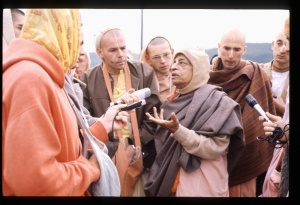CC Madhya 18.109

A.C. Bhaktivedanta Swami Prabhupada
TEXT 109
prabhu kahe,—‘kāhāṅ pāilā kṛṣṇa daraśana?’
loka kahe,—‘sannyāsī tumi jaṅgama-nārāyaṇa
SYNONYMS
prabhu kahe—Śrī Caitanya Mahāprabhu further inquired; kāhāṅ pāilā—where have you gotten; kṛṣṇa daraśana—sight of Kṛṣṇa; loka kahe—the respectable persons replied; sannyāsī tumi—You are a sannyāsī; jaṅgama-nārāyaṇa—moving Nārāyaṇa.
TRANSLATION
Śrī Caitanya Mahāprabhu then asked them, “Where have you seen Kṛṣṇa directly?” The people replied, “You are a sannyāsī, a renunciant; therefore You are a moving Nārāyaṇa [jaṅgama-nārāyaṇa].”
PURPORT
This is the viewpoint of Māyāvāda philosophy. Māyāvāda philosophy supports the impersonalist view that Nārāyaṇa, the Supreme Personality of Godhead, has no form. One can imagine impersonal Brahman in any form—as Viṣṇu, Lord Śiva, Vivasvān, Gaṇeśa or Devī Durgā. According to the Māyāvāda philosophy, when one becomes a sannyāsī he is to be considered a moving Nārāyaṇa. Māyāvāda philosophy holds that the real Nārāyaṇa does not move because, being impersonal, He has no legs. Thus according to Māyāvāda philosophy, whoever becomes a sannyāsī declares himself Nārāyaṇa. Foolish people accept such ordinary human beings as the Supreme Personality of Godhead. This is called vivarta-vāda.
In this regard, Śrīla Bhaktisiddhānta Sarasvatī Ṭhākura comments that jaṅgama-nārāyaṇa means that the impersonal Brahman takes a shape and moves here and there in the form of a Māyāvādī sannyāsī. The Māyāvāda philosophy confirms this. Daṇḍa-grahaṇa-mātreṇa naro nārāyaṇo bhavet: “Simply by accepting the daṇḍa of the order of sannyāsa, one is immediately transformed into Nārāyaṇa.” Therefore Māyāvādī sannyāsīs address one another by saying oṁ namo nārāyaṇāya. In this way one Nārāyaṇa worships another Nārāyaṇa.
Actually an ordinary human being cannot become Nārāyaṇa. As the chief Māyāvādī sannyāsī, Śrī Śaṅkarācārya, says, nārāyaṇaḥ paro ’vyaktāt: “Nārāyaṇa is not a creation of this material world. Nārāyaṇa is above the material creation.” Due to their poor fund of knowledge, Māyāvādī sannyāsīs think that Nārāyaṇa, the Absolute Truth, takes birth as a human being and that when He realizes this, He becomes Nārāyaṇa again. They never consider why Nārāyaṇa, the Supreme Personality of Godhead, would accept an inferior position as a human being and then again become Nārāyaṇa when He is perfect. Why should Nārāyaṇa be imperfect? Why should He appear as a human being? Śrī Caitanya Mahāprabhu very nicely explained these points while at Vṛndāvana.